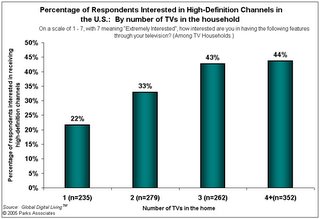Klopfenstein Participant Observer Research: This Should Be HDTV's Breakthrough Year
© 2005, Dr. Bruce Klopfenstein. Best viewed in Firefox.
A year ago, I spent over 2 months acting as a sales floor representative in the home video department of a large, national electronics retail chain. While sales of HDTV sets last year was impressive, it was clear that many would-be adopters put off the decision because of 1) lack of HDTV programming (especially on DVD), 2) price (which had dropped dramatically from Christmas 2003), and 3) very importantly, confusion over the price/value question as it related to an even more confusion of competing HDTV set designs. The HDTV position now might be comparable to the diffusion of color TV, although CBS was not anxious to promote rival NBC-owned RCA new color TV set and ABC had the most difficult financial situation to make the switch to color. While those issues are not present with HDTV, the common variable is limited programming.

Source: http://www.parksassociates.com/research/reports/tocs/2005/hdtv.htm
As noted by RTOonline.com, "The overall market penetration for high-definition televisions and services is very low. The current subscription rate for HD programming is barely 10% among all digital video subscribers, while only 35% of total HDTV households subscribe to HD video services." Source: Study: US HDTV Sales To Grow 71% By 2009, http://www.rtoonline.com/Content/Article/Oct05/HDTVSalesTOGrow102805.asp, retrieved 25 December 2005. I want to point out that this article was citing a research study from Parks Associates' "Mobile Entertainment Platforms & Services" study of notoriously invalid "intention to purchase" research:
There is the typical "chicken and egg" situation: HDTV programming availability vs. HDTV adoption rate. On the other hand, many (all?) major sports events are being broadcast in HDTV and many (all?) national and international news organizations use 16 by 9 monitors prominently in their newscasts, making it see more of a mainstream product. In addition, the U.S. has one of the best competitive markets with 2 satellite companies competing with each other and the cable companies trying to fend off the satellite competition. The brakes could be put on by consumers given theuncertainn state of the economy as well as the expected high cost of heating homes this winter. That's usually a throw-away line, but this year cost of energy will be a real drain on consumers' ability to spend. It's been a long time since that was included as a possible barrier to a new communication technology.
 Thanks blogger community for solving my mysterious error. I'll hang on to
Thanks blogger community for solving my mysterious error. I'll hang on to 





